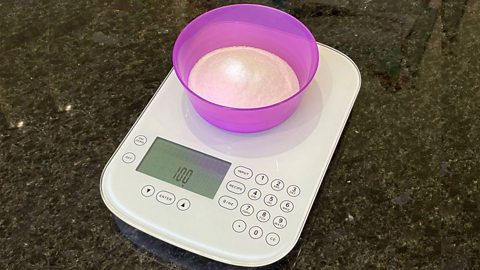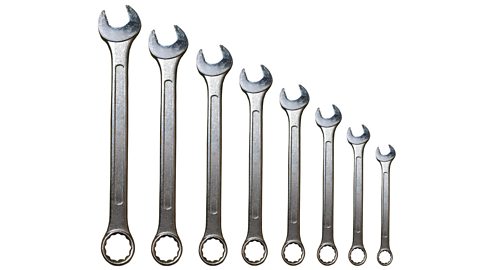Key points
The terms weightA force that acts on mass, pulling it down, due to gravity. Weight is a force and forces are measured in newtons (N). and massA measure of the amount of matter an object is made out of. Mass is measured in kilograms (kg). are often wrongly used to describe the same thing.
In science, weight and mass are very different.
Weight versus mass
The terms weight and mass are often used incorrectly. Phrases like ‘a bag of sugar weighs 1 kg’ are not scientifically correct.
Mass is a measure of the amount of matterAny substance that has mass and takes up space by having volume. Matter can be solid, liquid or gas. an object is made out of. Mass is measured in kilograms (kg). Very small masses are sometimes measured in grams (g). There are 1000 g in one kg.
Weight is the force that acts on mass due to gravity and is therefore measured in newtons (N).
Calculating weight and mass
The following equation can be used to calculate the weight of an object:
\(W = m \times g\)
\(Weight~(N) = mass~(kg) \times gravitational~field~strength~(N/Kg)\)
The gravitational field strength The force that attracts one kilogram towards another massive object, like a planet. Gravitational field strength has the symbol g and it is measured in newtons per kilogram (N/kg). on Earth is 10 N/kg.
This means that a 1 kg mass would be attracted to Earth by a force of 10 N.
How to calculate weight
An apple has a mass of 0.2 kg. Calculate the weight of the apple on Earth (g = 10 N/kg).
W = ?
m = 0.2 kg
g = 10 N/kg
Use the weight equation:
\(W = m \times g\)
and substitute in the values you know:
\(W = 0.2 \times 10\)
\(W = 2~N\)
The weight of the apple on Earth is 2 N.
How to calculate mass
A big textbook weighs 90 N. Calculate the mass of the book (g = 10 N/kg).
W = 90 N
m = ?
g = 10 N/kg
Remember to use the equation:
\(W = m \times g\)
Substitute in the values you know:
\(90 = m \times10\)
Now divide both sides by 10:
\( \frac{90}{10} = \frac{m \times 10}{10}\)
\( 9 = m \)
\( m = 9~kg \)
The mass of the book is 9 kg.
Now have a go at answering this question.
A student has a mass of 45 kg. The gravitational field strength on Earth is 10 N/kg. What is the weight of the student?
The weight of the student is 450 N.
This is calculated by multiplying their mass by the gravitational field strength.
45 x 10 = 450.
Weight and other planets
weightA force that acts on mass, pulling it down, due to gravity. Weight is a force and forces are measured in newtons (N). is a result of gravity interacting with massA measure of the amount of matter an object is made out of. Mass is measured in kilograms (kg).. This means that an object’s weight will change depending on the strength of the gravitational field strength The force that attracts one kilogram towards another massive object, like a planet. Gravitational field strength has the symbol g and it is measured in newtons per kilogram (N/kg). acting on it.
Different objects that are in our Universe have gravitational fields of varying strengths.

Did you know?
The planets in our solar system have different gravitational field strengths.
For example, the gravitational field strength on Earth is 10 N/kg whereas on Jupiter it is 24.7 N/kg.
This means that a mass of 50 kg will weigh just over double on Jupiter than it would on Earth.

The table shows the different gravitational field strengths for each of the different planets.
| Planet | Gravitational field strength (N/kg) |
|---|---|
| Mercury | 4 |
| Venus | 9 |
| Earth | 10 |
| Mars | 4 |
| Jupiter | 23 |
| Saturn | 9 |
| Uranus | 9 |
| Neptune | 11 |
We can also calculate how an object’s weight would be different on different planets.
For example, because the gravitational field strength on Earth is 10 N/kg, if a person has a mass of 60 kg their weight on Earth would be calculated as follows:
\(W = m \times g\)
\(W = 60 \times 10\)
\(W = 600 N\)
However on Mars, which has a gravitational field strength of 4 N/kg, the same person’s weight would be:
\(W = m \times g\)
\(W = 60 \times 4\)
\(W = 240 N\)
More about weight and mass
Watch the video of physicist Jon Chase explaining that the mass of an object is constant but its weight depends on the gravitational force.
If you travelled to another planet, it's not just extra-terrestrials you might have to contend with, you might also weigh twice as much as you would on earth. Now, it might sound a bit strange, but finding out about how our weight would change on different planets of the solar system, is linked to understanding how forces act.
And I've come to the fairground to find out more.
Gravity is a force. It attracts objects with mass towards each other.
In space, it might look like there's no gravity, but astronauts are weightless because they're in orbit, so they're constantly falling towards the earth.
The weight of something depends on its mass and the gravitational field strength.
Weight is measured in Newtons and mass is measured in kilograms. Weight is a force. And it's caused by the pull of gravity acting on a mass. Mass is the amount of matter in an object. Unlike weight, it's not a force.
An object's mass has the same value anywhere in the universe. On other planets, our mass stays the same, but our weight would change. That's because the gravitational force region on different planets is different.
Some of my mates have come down to help me show you what I mean. It's not the warmest of days here on Earth, but I'm not one to let a bit of cold get in the way of a science demo.
Guys, do you have any idea what it would be like to be on another planet and what it would feel like, what you'd weigh?
ALL: No.
Well, this ride will give us some idea of that. Let's give it a go.
So we are presently, currently on planet Earth. Let's do a visit to Jupiter.
OK. Yeah, ready, ready.
Oh, no, I'm scared!
YELLING
LAUGHTER
YELLING
We are still alive.
Whoo!
Right, so what part of that ride felt the lightest?
At the top. It made your stomach go funny, dizzy. Dizzy stomach. Dizzy stomach!
And when did you feel the heaviest?
As it, kind of, came to the bottom. A little bounce.
Wicked! You see, that ride is like actually being on other planets.
When you was at the top and at the lightest, it's like being on a planet with less gravity, like Mercury. But when you was at the bottom on that bouncy part where you felt a bit heavier, well, that heavy feeling, that's like being on a bigger planet. For example, like Jupiter.
Except you wouldn't just be feeling like that when you hit the bottom, you'd just always feel like that.
Being on a ride like this is the closest you can really get to actually being on another planet.
LAUGHTER. Yeah!
Because we know that our mass is constant, it must be the gravitational forces that make our weight change. On Earth, the force of gravity on a one-kilogram mass is ten Newtons.
So, if my mass is 70 kilograms, then the force of gravity on me makes my weight 700 Newtons. As the chair and I fall, I'm pressing less on the chair and appear lighter.
Similar to astronauts in the space station. This would be the same feeling on Mercury. There, the force of gravity on a one-kilogram mass is just four Newtons. So, if my mass is 70 kilograms, then the force of gravity on me makes me weigh about 280 Newtons.
That's like me weighing as much as your family dog.
BARKING
At the bottom of the ride when it starts to slow down, the forces were unbalanced and I felt much heavier. This would be the same feeling on Jupiter. There, the force of gravity on a one-kilogram mass is 25 Newtons.
So, if my mass is 70 kilograms, then the force of gravity on me makes my weight about 1,750 Newtons. This is like weighing as much as a gorilla. So, the greater the mass of the object,the stronger the force of gravity.
That's why you'd weigh more on Jupiter. Gravity also keeps planets and moons in orbit. We know the gravitational pull of an object is determined by its mass. This can also help us make sense of the movement of the whole solar system.
All the planets and moons in the solar system spin around a central point. A bit like me on this roundabout.The object with the greatest mass sits at the centre and its gravitational pull attracts other objects into an orbit around it.
And that's why every planet in our solar system orbits the Sun. It's all down to gravity.
Measuring weight and mass

As with most quantities in science you need to know how you can find the mass and weight of objects.
To find an object’s mass you need to use a balanceA piece of scientific equipment used to measure mass. .
It is important that you set the balance to 0 before placing any object on it so that your reading is accurateA measurement that is close to the true value..


Once you have used the balance to find the mass of an object you can then complete a calculation using the weight equation to calculate the weight of the object.
\(W = m \times g\)
You can also use a newton meter, sometimes called a force meter, to measure the weight of an object too.
A newton meter has a spring in it, which extends due to the weight of the object you hang from the hook at the bottom. The scale on the newton meter then indicates the amount the object weighs.

Atomic Labs game. gameAtomic Labs game
Try out practical experiments in this KS3 science game

More on Forces and movement
Find out more by working through a topic
- count7 of 16

- count8 of 16

- count9 of 16

- count10 of 16
